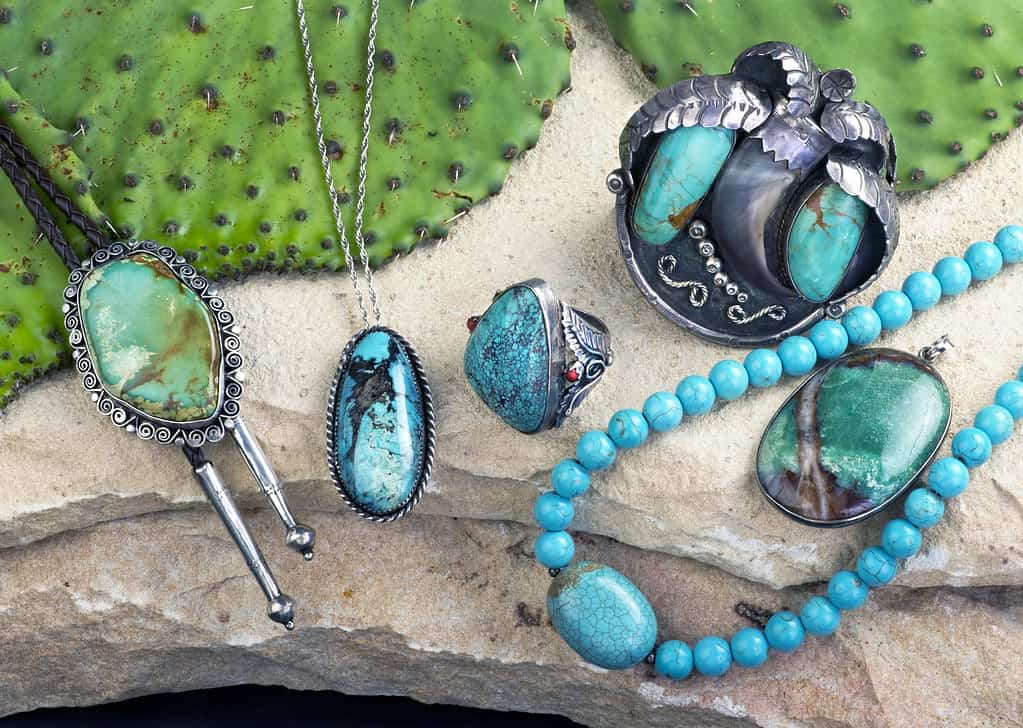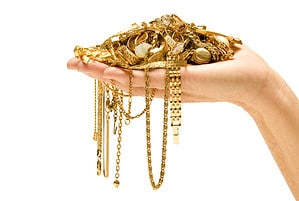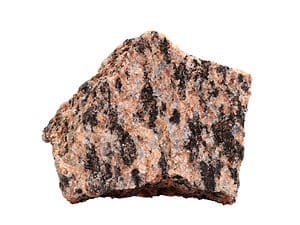
Bracelets made from turquoise like these offer protection. It’s said that each stone recognizes and stands for major life events that the wearer, and perhaps her ancestors, went through.
©Jerry Sodorff/iStock via Getty Images
Turquoise is closely associated with a few groups, such as Native Americans, Turks, Tibetan people, and Persians. While other groups used and had turquoise, these groups were the main users. They placed a lot of importance on the stone and had many ideas on turquoise’s symbolism.
Turquoise is a stone that ranges in color from sky blue to dark teal, depending on where it’s found. Most versions of the stone have matrices, which are the black, brown, or dark blue patterns in the stone, but some are very clear and lack the pattern.
To learn more about turquoise and the groups that used this stone, continue reading below.
Symbolism and Beliefs Surrounding Turquoise

Turquoise was mostly used for protection and wisdom, but it did have other purposes on occasion.
©AkulininaOlga/Shutterstock.com
Turquoise has a strong history with Native Americans. Various tribes and groups put a heavy value on turquoise. They believed the stone offered a connection to the god of the sky and acted as a conduit between the earth and heaven. By using it as a conduit, it was possible to channel the energy of heaven into healing.
This also meant the stone worked to ground people. By using stones that offered grounding, it allowed the wearer to balance their inner and outer harmony. This, in turn, allows them to stay calm and peaceful. The sides of yourself associated with reason, intuition, and emotion balance and create a state of understanding.
Protection is another benefit of turquoise. Specifically, the stone symbolized protection during travel. Originally, it only included traveling on horses, but it has since expanded to other forms including cars, ships, and planes.
Some say that turquoise also offers protection by warning users that something bad is going to happen. Similar to malachite, turquoise is said to break if danger approaches the owner. A color change also symbolizes an approaching illness.
History and Uses of Turquoise

Even now, Native Americans make much of their jewelry with turquoise.
©mj0007/iStock via Getty Images
Turquoise was valuable to many cultures. In the Americas, Aztecs and other Native Americans found turquoise to be incredibly valuable. They treasured the stone more than the Spanish treasured gold and emeralds.
Native Americans
Turquoise has many purposes. Various tribes of Native Americans wore the stone during battles as added protection. Amulets, charms, and other decorations adorned those going to fight to provide as much safety as possible.
The stones also decorated arrows and bows. The stones reportedly improved the accuracy of shots.
In more desert regions of the U.S., Native American tribes like the Lakota-Souix and Navajos used the stone to help bring rain. By using these stones and completing a ritual, the tribes asked the god of rain to let water fall upon the earth. The turquoise was often ground with coral to make a sand-like texture.
Many other tribes wore turquoise on their person to protect them from harm, illnesses, curses, and negative energies. The shamans of tribes used the stone to assist them in healing rituals.
Do you know the myth that if you make it to the end of a rainbow, there will be a pot of gold waiting for you? The Apache believed that if you made it to the end of the rainbow after a storm, turquoise could be found in the earth left damp by the rain.
Persians and Turks
It wasn’t only the Native Americans who found that turquoise offered some benefits. The people from Turkey and Persia also found turquoise offered protection. Like the Native Americans, many of the people in this region used the stone in their swords, armor, and the saddles and bridles their horses wore.
Falling from horses often was one of the biggest dangers during wars, and so the Turks and Persians thought turquoise protected them from the dangers that came with falling during battle.
Turquoise also improved the mentality of people who wore it. Specifically, wearing turquoise increased courage, allowed one to master their fear, and brought fortune and happiness.
Other Parts of the World
Greece, England, Russia, and Tibet also used turquoise. In Greece, women often wore the stone to symbolize and promote their purity. Meanwhile, in England, women offered up the stones to their lovers to show their dedication to enduring love. For those in Russia, the stones also symbolized love and were often included in wedding rings.
Tibet’s belief in the stone varied a bit. They thought the unique color shift of turquoise from green to blue represented life and death, as well as wisdom.
The photo featured at the top of this post is © Nikolay Pozdeev/iStock via Getty Images
Thank you for reading! Have some feedback for us? Contact the AZ Animals editorial team.







